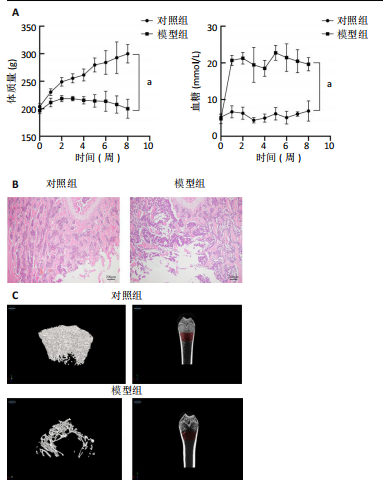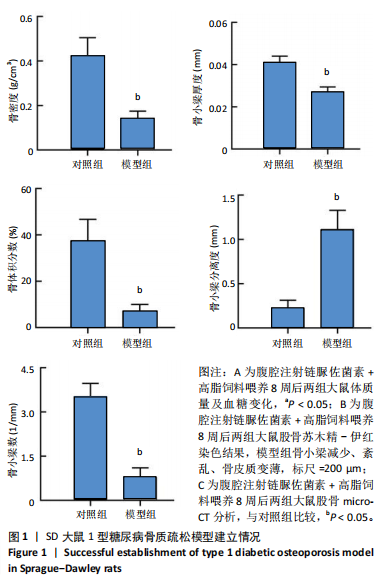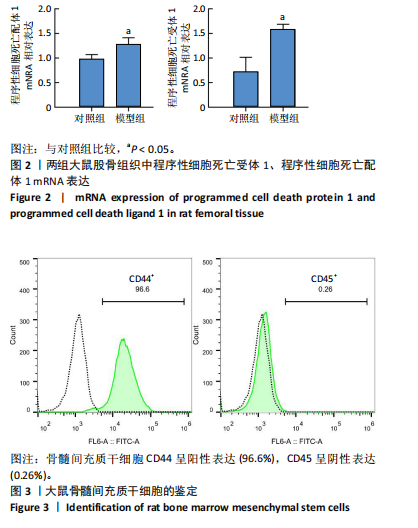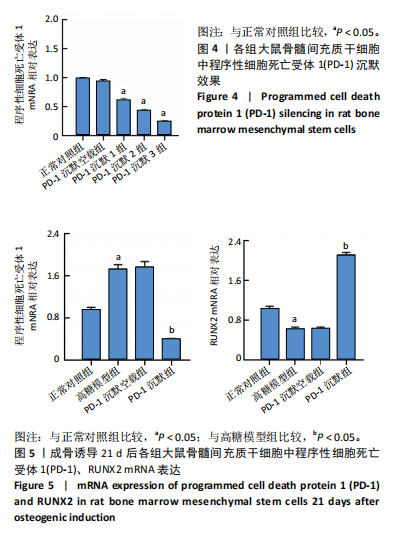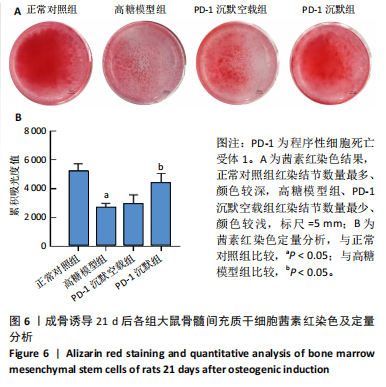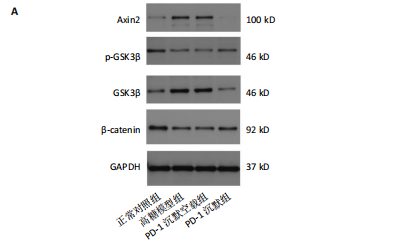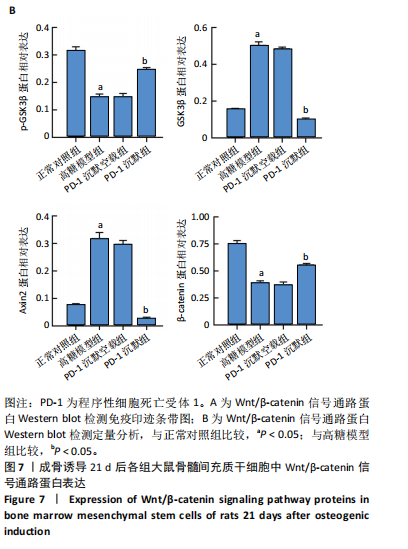[1] 谷营营,侯甜,秦雅芝,等.特立帕肽通过 Wnt3a/β-catenin 通路对高糖环境下成骨细胞分化的影响[J].安徽医科大学学报,2022, 57(11):1750-1755.
[2] KALRA S, JOSHI A, KAPOOR N. Osteoporosis and diabetes: The dual pandemics. J Pak Med Assoc. 2022;72(8):1663-1664.
[3] 苏婧,潘韦韦,崔镇海,等.糖尿病性骨质疏松中西医发病机制及治疗的研究进展[J].吉林中医药,2023,43(5):612-617.
[4] 刘中胜,杨建虹.未羧化骨钙素对高糖条件下小鼠骨髓间充质干细胞成骨与成脂分化的调控效应[J]. 中国组织工程研究,2020, 24(13):2039-2046.
[5] BRUNETTI G, D’AMATO G, DE SANTIS S, et al. Mechanisms of altered bone remodeling in children with type 1 diabetes. World J Diabetes. 2021;12(7):997-1009.
[6] AGARWAL A, LESLIE WD. Fracture prediction tools in diabetes. Curr Opin Endocrinol Diabetes Obes. 2022;29(4):326-332.
[7] 焦颖华,郭倩,包凯然,等.仙灵骨葆胶囊对糖尿病骨质疏松大鼠 β-catenin、Runx2、LRP5 的影响[J].中药新药与临床药理,2023, 34(2):156-162.
[8] 崔寅鹏,郭艾,马立峰,等.哇巴因体外诱导人骨髓间充质干细胞的成骨分化[J].中国组织工程研究,2022,26(24):3796-3801.
[9] MANTRIPRAGADA VP, KAPLEVATSKY R, BOVA WA, et al. Influence of Glucose Concentration on Colony-Forming Efficiency and Biological Performance of Primary Human Tissue-Derived Progenitor Cells. Cartilage. 2021;13(2_suppl):95S-106S.
[10] 常俊杰,解强,刘亦冰,等.高糖对骨髓间充质干细胞作用机制的研究进展[J].中国骨质疏松杂志,2022,28(10):1551-1555.
[11] CAI F, LIU Y, LIU K, et al. Diabetes mellitus impairs bone regeneration and biomechanics. J Orthop Surg Res. 2023;18(1):169.
[12] KAWADA-HORITANI E, KITA S, OKITA T, et al. Human adipose-derived mesenchymal stem cells prevent type 1 diabetes induced by immune checkpoint blockade. Diabetologia. 2022;65(7):1185-1197.
[13] GAO M, SHI J, XIAO X, et al. PD-1 regulation in immune homeostasis and immunotherapy. Cancer Lett. 2024;588:216726.
[14] LIN Z, XIONG Y, MENG W, et al. Exosomal PD-L1 induces osteogenic differentiation and promotes fracture healing by acting as an immunosuppressant. Bioact Mater. 2021;13:300-311.
[15] GREISEN SR, KRAGSTRUP TW, THOMSEN JS, et al. The Programmed Death-1 Pathway Counter-Regulates Inflammation-Induced Osteoclast Activity in Clinical and Experimental Settings. Front Immunol. 2022; 13:773946.
[16] LEE SC, SHIN MK, JANG BY, et al. Immunomodulatory Effect and Bone Homeostasis Regulation in Osteoblasts Differentiated from hADMSCs via the PD-1/PD-L1 Axis. Cells. 2022;11(19):3152.
[17] SUN Y, ZHU Y, LIU X, et al. Morroniside attenuates high glucose-induced BMSC dysfunction by regulating the Glo1/AGE/RAGE axis. Cell Prolif. 2020;53(8):e12866.
[18] DAAMOUCH S, EMINI L, RAUNER M, et al. MicroRNA and Diabetic Bone Disease. Curr Osteoporos Rep. 2022;20(3):194-201.
[19] TOMASIUK JM, NOWAKOWSKA-PŁAZA A, WISŁOWSKA M, et al. Osteoporosis and diabetes-possible links and diagnostic difficulties. Reumatologia. 2023;61(4):294-304.
[20] FAN D, LU J, YU N, et al. Curcumin Prevents Diabetic Osteoporosis through Promoting Osteogenesis and Angiogenesis Coupling via NF-kappaB Signaling. Evid Based Complement Alternat Med. 2022; 2022:4974343.
[21] XU C, WANG Z, LIU YJ, et al. Harnessing GMNP-loaded BMSC-derived EVs to target miR-3064-5p via MEG3 overexpression: Implications for diabetic osteoporosis therapy in rats. Cell Signal. 2024;118:111055.
[22] LUO M, ZHAO Z, YI J. Osteogenesis of bone marrow mesenchymal stem cell in hyperglycemia. Front Endocrinol (Lausanne). 2023;14:1150068.
[23] YANG N, LIU Y. The Role of the Immune Microenvironment in Bone Regeneration. Int J Med Sci. 2021;18(16):3697-3707.
[24] DING P, GAO C, GAO Y, et al. Osteocytes regulate senescence of bone and bone marrow. Elife. 2022;11:e81480.
[25] ZHOU M, GRAVES DT. Impact of the host response and osteoblast lineage cells on periodontal disease. Front Immunol. 2022;13:998244.
[26] DING JT, YANG KP, LIN KL, et al. Mechanisms and therapeutic strategies of immune checkpoint molecules and regulators in type 1 diabetes. Front Endocrinol (Lausanne). 2023;13:1090842.
[27] LI N, LI Z, FU L, et al. PD-1 Suppresses the Osteogenic and Odontogenic Differentiation of Stem Cells from Dental Apical Papilla via Targeting SHP2/NF-kappaB Axis. Stem Cells. 2022;40(8):763-777.
[28] MA L, GONG F, XU J, et al. Uncarboxylated osteocalcin reverses the high glucose-induced inhibition of the osteogenic differentiation of MC3T3E1 cells via the GPRC6A/cAMP/PKA/AMPK signaling pathway. Int J Mol Med. 2021;47(5):91.
[29] ZHANG Y, YANG JH. Activation of the PI3K/Akt pathway by oxidative stress mediates high glucose-induced increase of adipogenic differentiation in primary rat osteoblasts. J Cell Biochem. 2013; 114(11):2595-2602.
[30] 饶艳玲,黄威.青娥丸调控Wnt1/β-catenin信号通路治疗糖尿病性骨质疏松症[J].中国骨质疏松杂志,2023,29(8):1167-1171,1181.
[31] YAN Z, RUAN B, WANG S, et al. RNA-binding Protein QKI Inhibits Osteogenic Differentiation Via Suppressing Wnt Pathway. Arch Med Res. 2023;54(5):102853.
[32] ZHAO SJ, KONG FQ, JIE J, et al. Macrophage MSR1 promotes BMSC osteogenic differentiation and M2-like polarization by activating PI3K/AKT/GSK3beta/beta -catenin pathway. Theranostics. 2020;10(1):17-35.
[33] ZHANG YL, AN Y, SUN LJ, et al. NADPH-dependent ROS accumulation contributes to the impaired osteogenic differentiation of periodontal ligament stem cells under high glucose conditions. Front Endocrinol (Lausanne). 2023;14:1152845.
[34] BAO K, JIAO Y, XING L, et al. The role of wnt signaling in diabetes-induced osteoporosis. Diabetol Metab Syndr. 2023;15(1):84.
[35] ZHANG C, BAO LR, YANG YT, et al. Role of M2 Macrophage Exosomes in Osteogenic Differentiation of Mouse Bone Marrow Mesenchymal Stem Cells under High-Glucose and High-Insulin. Sichuan Da Xue Xue Bao Yi Xue Ban. 2022;53(1):63-70.
[36] DIENELT A, KELLER KC, ZUR NIEDEN NI. High glucose impairs osteogenic differentiation of embryonic stem cells via early diversion of beta-catenin from Forkhead box O to T cell factor interaction. Birth Defects Res. 2022;114(16):1056-1074.
[37] MASSON SWC, DISSANAYAKE WC, BROOME SC, et al. A role for beta-catenin in diet-induced skeletal muscle insulin resistance. Physiol Rep. 2023;11(4):e15536.
[38] CHEN Y, CHEN L, HUANG R, et al. Investigation for GSK3beta expression in diabetic osteoporosis and negative osteogenic effects of GSK3beta on bone marrow mesenchymal stem cells under a high glucose microenvironment. Biochem Biophys Res Commun. 2021;534:727-733.
[39] LI Z, ZHAO H, CHU S, et al. miR-124-3p promotes BMSC osteogenesis via suppressing the GSK-3beta/beta-catenin signaling pathway in diabetic osteoporosis rats. In Vitro Cell Dev Biol Anim. 2020;56(9):723-734.
[40] 罗诒财,钟晓霞,李昊.罗汉果苷V通过Wnt/β-catenin信号通路对糖尿病状态成骨细胞增殖与分化的影响[J].中国医院药学杂志, 2022,42(8):781-785. |
